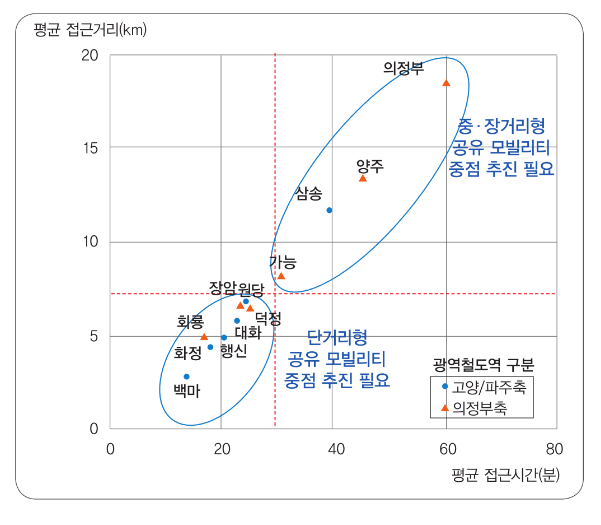List
Story > NEWS > Detail
[News] "The Collaboration of Shared Mobility and Public Transportation"
The Seoul-based metropolitan area has become more and more extensive. As a result, many commuters are also getting busy because of the increasing number. This can be described as the wide-area of passage. According to data from the Ministry of Land, Infrastructure and Transport, the average speed of commuting time between Seoul and its surrounding cities is less than 40 km/h. Only expanding the road infrastructure has been a strategy so far.However, this is only a temporary relief. Therefore, it is essential to manage traffic demand through the revitalization of public transportation. However, just to activate public transportation, proper provision of landline services for access to public transportation in the wide area is required. In short, we need a microvascular that connects the arteries and veins.

As a way to address this, a common mobility-based geotechnical service is emerging. Many of the most widely distributed areas are vulnerable to public transportation, which take more than twice the amount of time to approach the city or town bus from the surrounding city of Seoul to the metropolitan railway station. To address this, it is necessary to activate shared mobility as an alternative to existing branch line services.

Before we talk about our case, let's talk about how we are using shared mobility with the wide-area transportation network overseas. Overseas, we support the development of sub-regional areas as a way to improve access to major metropolitan railway stations, and provide shared mobility such as car handling, public bicycle, and ride sharing. Metrolinx, a transportation management agency in Toronto and Hamilton, Canada, has set up a strategy to develop reverse power by setting a major railway station as a wide-area hub. Metro, a wide-area transportation agency in Los Angeles County in the U.S., is also introducing a seamless facility between public transportation and shared mobility. In Atlanta, the company is conducting a pilot project of integrated services for wide-area operators in a way that the public transport service is handled during the period of operation. In Florida, in particular, if a passenger doesn't match a passenger when he or she returns home, he or she is offering a taxi-use discount ticket as an alternative.

So how can we promote cooperation between public transport and shared mobility in the future? If public transportation to and from the metropolitan railway station is widely distributed in areas where public transportation is vulnerable, such as bus access, it is necessary to supplement the operation of local buses and village buses by means of 캬sharing or sharing of rides. And for short distances, the introduction of shared bicycles and so on is an appropriate alternative.
However, there is a risk that car-sharing or ride-sharing will not be activated at the point of simply authorising the operation. Incentives should be provided to expand the users of the passenger compartment at the center of their residence or workplaces, and to ensure continued driver compensation (e.g. parking lot discounts, etc.) for the driver's and passengers.
Above all, in order to achieve the purpose of "the convenience of citizens in the metropolitan area," various indicators on transportation, land use, etc. should be used to make a comprehensive judgment on the accessibility of public transportation to the metropolitan area. And based on that, we will have to make relevant plans and push ahead with the project.
Currently, Korea is suffering from the introduction of carpool, or passenger sharing service. Rebellion by Korean IT giants and the taxi industry is reaching an extreme that would kill people. However, the unconditional opposition is not right, and the unilateral project without discussions with the relevant industry is not right. Travel sharing and car-sharing in areas with low public access to traffic can be a new opportunity for the development of public transportation while circumventing the current problem.
<Reference: Kim Gwang-ho, Oh Seong-ho, Yoon Seo-yeon, Park Jong-il, 2017 "A Study on the Improvement of Accessibility in Metropolitan Area Using Shared Mobility, Sejong: The National Institute of National Territory"
The Seoul-based metropolitan area has become more and more extensive. As a result, many commuters are also getting busy because of the increasing number. This can be described as the wide-area of passage. According to data from the Ministry of Land, Infrastructure and Transport, the average speed of commuting time between Seoul and its surrounding cities is less than 40 km/h. Only expanding the road infrastructure has been a strategy so far.However, this is only a temporary relief. Therefore, it is essential to manage traffic demand through the revitalization of public transportation. However, just to activate public transportation, proper provision of landline services for access to public transportation in the wide area is required. In short, we need a microvascular that connects the arteries and veins.

As a way to address this, a common mobility-based geotechnical service is emerging. Many of the most widely distributed areas are vulnerable to public transportation, which take more than twice the amount of time to approach the city or town bus from the surrounding city of Seoul to the metropolitan railway station. To address this, it is necessary to activate shared mobility as an alternative to existing branch line services.

Before we talk about our case, let's talk about how we are using shared mobility with the wide-area transportation network overseas. Overseas, we support the development of sub-regional areas as a way to improve access to major metropolitan railway stations, and provide shared mobility such as car handling, public bicycle, and ride sharing. Metrolinx, a transportation management agency in Toronto and Hamilton, Canada, has set up a strategy to develop reverse power by setting a major railway station as a wide-area hub. Metro, a wide-area transportation agency in Los Angeles County in the U.S., is also introducing a seamless facility between public transportation and shared mobility. In Atlanta, the company is conducting a pilot project of integrated services for wide-area operators in a way that the public transport service is handled during the period of operation. In Florida, in particular, if a passenger doesn't match a passenger when he or she returns home, he or she is offering a taxi-use discount ticket as an alternative.

So how can we promote cooperation between public transport and shared mobility in the future? If public transportation to and from the metropolitan railway station is widely distributed in areas where public transportation is vulnerable, such as bus access, it is necessary to supplement the operation of local buses and village buses by means of 캬sharing or sharing of rides. And for short distances, the introduction of shared bicycles and so on is an appropriate alternative.
However, there is a risk that car-sharing or ride-sharing will not be activated at the point of simply authorising the operation. Incentives should be provided to expand the users of the passenger compartment at the center of their residence or workplaces, and to ensure continued driver compensation (e.g. parking lot discounts, etc.) for the driver's and passengers.
Above all, in order to achieve the purpose of "the convenience of citizens in the metropolitan area," various indicators on transportation, land use, etc. should be used to make a comprehensive judgment on the accessibility of public transportation to the metropolitan area. And based on that, we will have to make relevant plans and push ahead with the project.
Currently, Korea is suffering from the introduction of carpool, or passenger sharing service. Rebellion by Korean IT giants and the taxi industry is reaching an extreme that would kill people. However, the unconditional opposition is not right, and the unilateral project without discussions with the relevant industry is not right. Travel sharing and car-sharing in areas with low public access to traffic can be a new opportunity for the development of public transportation while circumventing the current problem.
<Reference: Kim Gwang-ho, Oh Seong-ho, Yoon Seo-yeon, Park Jong-il, 2017 "A Study on the Improvement of Accessibility in Metropolitan Area Using Shared Mobility, Sejong: The National Institute of National Territory"



